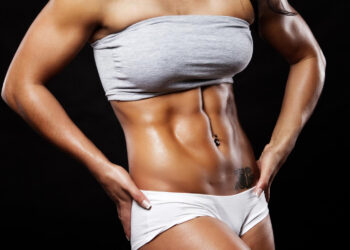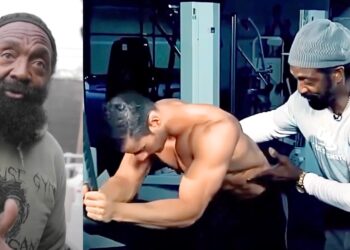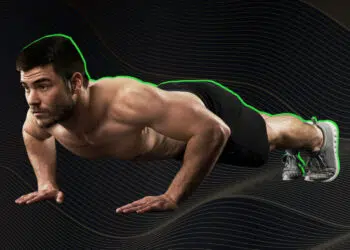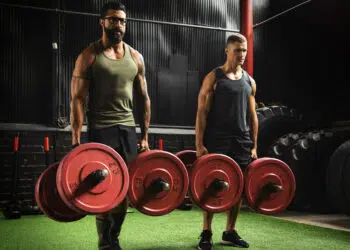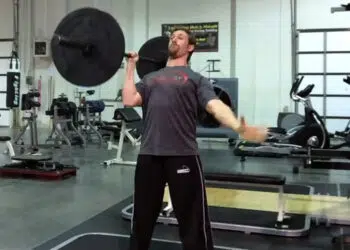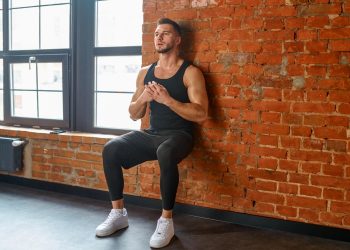Although no one has ever counted, there are probably more exercises for the abs than any other muscle group. There are bodyweight, cable, kettlebell, freeweight, floor and mat-based, standing, kneeling, isometric, and isotonic exercises for the abs.
Why is this?
The most likely reason is that almost everyone who works out wants a six-pack and, as such, spends a disproportionate amount of time training their abs.
Sadly, you need more than lots of abs-specific exercises to get a six-pack. That’s because, to see your abs, you also need a low level of body fat. Simply put, if you aren’t lean, your abs will be obscured by a layer of fat, and you might not be able to feel them, let alone see them.
So, if you want abs, you must eat according to your goal. That said, direct abs training will thicken your abdominal wall, making it more visible at a higher percentage of body fat.
As already mentioned, there are hundreds of abs exercises to choose from, and some are better than others.
Level Up Your Fitness: Join our 💪 strong community in Fitness Volt Newsletter. Get daily inspiration, expert-backed workouts, nutrition tips, the latest in strength sports, and the support you need to reach your goals. Subscribe for free!
In this article, we explain why and how to do heel touches and provide you with a few useful variations and alternatives.
Heel Touches – Muscles Worked
Technically speaking, heel touches, also known as alternating heel taps, are an isolation exercise because they involve movement at just one joint – the spine. However, because there are two movements happening at once, heel touches actually work several important core muscles simultaneously.
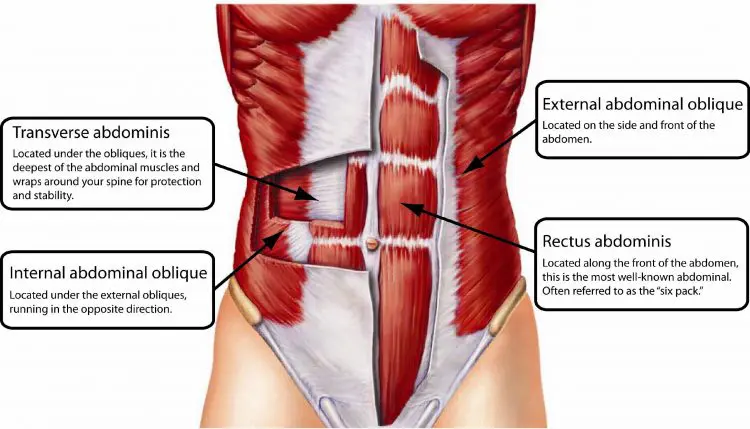
The primary muscles trained during heel taps are:
Rectus abdominus
The rectus abdominus is the long, flat muscle on the front of your abdomen. It’s separated by lines of ligamentous tissue, which give it a six-pack appearance. However, it’s important to note that this six-pack shape is only visible if body fat levels are low enough. How low depends on gender and genetics, but 10% is typical for men and 15% for women.
The main functions of the rectus abdominus are:
- Spinal flexion – bending your spine forward
- Lateral flexion – bending your spine to the side
- Compression of the abdominal contents – such as when you cough or exhale
Obliques
The obliques are located on the side of your abdomen. There are external and internal oblique muscles, but because they work together, most people refer to them as one muscle, simply called the obliques.
The main functions of the obliques are:
- Spinal rotation – twisting your spine
- Lateral flexion – bending your spine to the side
- Compression of the abdominal contents – such as when you cough or exhale
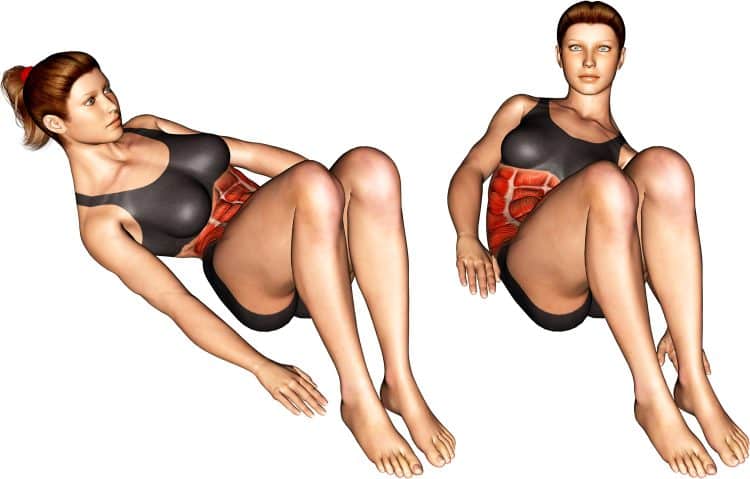
Transverse abdominus
Where the rectus abdominus runs vertically up the front of your abdomen, the transverse abdominus runs horizontally. Acting a lot like a weightlifting belt, your transverse abdominus encircles your abdominal contents and, when it contracts, helps increase intra-abdominal pressure to support and stabilize your spine.
While you can’t see the transverse abdominus, no matter how lean you get, it is still a critical muscle. It is directly involved in every abs exercise you do, especially those where you brace your midsection, i.e., planks.
The main functions of the transverse abdominus are:
- Compression of the abdominal contents – such as when you cough or exhale
- Stabilizing the lumbar spine and pelvis before movement of the lower and upper limbs can occur
How to Do Heel Touches
Get more from heel touches while keeping your risk of injury to a minimum by following these guidelines:
- Lie on your back with your legs bent and feet flat on the floor. Use a mat for comfort. Place your hands on the floor by your sides.
- Using your abs, lift your head and shoulders off the floor and reach toward your feet. Press your lower back into the floor and pull your chin in to keep your neck neutral.
- Keeping your abs contracted, lean to the left and to the right, touching your heels with your outstretched hands.
- Continue for the prescribed number of repetitions or until reaching muscular failure.
- Make this exercise significantly harder by lifting your feet off the floor or straightening your legs.
Do not hold your breath during this exercise, as doing so will starve your working muscles of oxygen and stop you from training as hard or as long as you otherwise could. It can also lead to significant rises in blood pressure. Instead, breathe in time with your movements.
Heel Touches Benefits and Drawbacks
Not sure if heel touches are the right exercise for your abs workouts? Consider these benefits and then decide!
- Easy to learn – heel touches are a straightforward exercise. It’s basically a side bend performed while lying on the floor. As such, it’s suitable for beginners and exercisers looking for a simple abs and oblique workout.
- Spine-friendly – there is minimal compression on your spine during side heel touches. In contrast, other waist exercises, such as side bends, involve significant levels of compression, which could make them a little less spine-friendly for some people. Heel touches may be more suitable for exercisers with mild back pain.
- No equipment required – while weighted abs exercises like cable crunches and dumbbell side bends are very effective, you need access to equipment to do them. Heel touches require just your body weight and somewhere to lie down, so they’re ideal for home exercisers.
- No set-up time – you can get into position and start a set of heel touches in seconds. This makes them ideal for fast-paced workouts like circuit training, HIIT, and supersets.
While heel touches are a mostly beneficial exercise, there are also a few drawbacks to consider:
Level Up Your Fitness: Join our 💪 strong community in Fitness Volt Newsletter. Get daily inspiration, expert-backed workouts, nutrition tips, the latest in strength sports, and the support you need to reach your goals. Subscribe for free!
- Limited overload – even if you work up to doing heel touches with both legs straight, you are still limited to using your body weight for resistance. As such, you may eventually outgrow this exercise and find you have to do high reps to fatigue the target muscles. This drawback is not unique to heel touches and applies to many bodyweight exercises.
- A small range of motion – heel touches involve about 20-30 degrees of lateral flexion and a similar amount of forward flexion, which is not a lot. Other abs exercises allow a wider range of motion. More movement can be advantageous, especially for athletes.
7 Heel Touch Variations and Alternatives
Heel touches are a highly effective abs and obliques exercise, but that doesn’t mean you need to do them all the time. There are several variations and alternatives you can use to keep your workouts productive and interesting:
1. Oblique crunches
The biggest drawback of heel touches is that there is very little resistance to lateral flexion. In other words, your obliques don’t actually have to do a lot of work to pull you from one side to the other. Oblique crunches pits your muscles against gravity for a much more demanding waist workout.
How to do it:
- Lie on your left side with your hips square and your legs bent. Place your left hand on the right side of your waist to provide feedback from the muscles you are working on. Put your right hand on the side of your head.
- Use your uppermost obliques to flex your torso and draw your right shoulder down toward your hip. Move slowly and deliberately, contracting your obliques as hard as you can.
- Pause at the top of each rep for 2-3 seconds, lie back down, and repeat.
- Roll over and do the same number of reps on the opposite side.
2. Side planks
Side planks are a classic core exercise that emphasizes your obliques. During this exercise, your muscles work isometrically, i.e., statically, to maintain your position. Your core often has to work like this in nature to maintain spinal stability, e.g., when carrying a heavy object in one hand.
How to do it:
- Lie on the floor on your side and rest on your forearm with your elbow directly under your shoulders.
- With your legs and hips straight, lift your body so your weight is supported on your arm and the sides of your feet only.
- Hold this position (but never your breath!) for the prescribed duration.
- Lower your hips down to the floor, roll over, and repeat on the opposite side.
3. Side plank leg raises
Side planks provide your obliques with a good workout, but, like most bodyweight abs exercises, all too soon, they will lose some of their effect, and you’ll need to do them for longer and longer. This side plank variation involves a leg raise which makes them more challenging. You can also do this exercise for reps instead of a predetermined time.
How to do it:
- Lie on your side with your body straight and resting on your bent arm. With your legs together, raise your hips up so your weight is supported on your lowermost foot and arm only. Brace your abs.
- Without raising or lowering your hips, lift your uppermost leg until your foot is roughly level with your shoulder.
- Lower your leg and repeat.
- Swap sides and do the same number of reps with the other leg.
4. Mason twists
The two main functions of the obliques are lateral flexion and rotation. Where heel touches emphasize the former, Mason twists are all about the latter. It’s generally best to train a muscle using all its available functions, so Mason twists are a great supplement to heel touches.
How to do it:
- Sit on the floor with your legs bent. Lean back and lift your feet a few inches off the floor, so you are balancing on your butt.
- Clasp your hands together in front of your chest.
- Without lowering your legs, turn your shoulders and touch your hands on the floor just outside your left hip.
- Switch sides and repeat.
- The faster you go, the more unstable you’ll be and the more challenging this exercise becomes.
- You can also do this exercise with weight, i.e., holding a dumbbell or medicine ball.
5. T-Rotation
We’re the first to admit that this exercise looks nothing like heel touches, yet it works the same muscles as well as your arms and shoulders. Also, just like heel touches, this exercise requires no equipment, so you can do it anywhere and anytime.
How to do it:
- Adopt the push-up position, also known as the high plank. Your arms should be straight, and your shoulders, hips, knees, and feet should form a line. Brace your abs.
- Shift your weight onto one hand, turn your shoulders and hips, and reach up to the ceiling with your free hand to form a side-on T-shape.
- Return to the high plank position and repeat on the opposite side.
- Keep your core braced throughout.
6. Single-arm dumbbell bench press
No, you haven’t accidentally clicked on a chest training article! In fact, single-arm dumbbell bench presses are a very effective abs and obliques exercise. That said, they do hit your chest, shoulders, and triceps, which makes them a very time-efficient compound exercise.
How to do it:
- Lie on a flat exercise bench with a dumbbell in one hand. Place your feet firmly on the floor and brace your abs. Press the weight up and hold it over your shoulder, arm vertical, and palm facing down toward your legs.
- Without allowing your shoulders or hips to rotate, bend your arm and lower the dumbbell down to your shoulder.
- Press it back up and repeat.
- At the end of your set, swap arms and do the same number of reps on the opposite side.
- You can also do this exercise using a kettlebell or lying on the floor if you don’t have a workout bench.
7. Floor wipers
This exercise is a whole lot harder than heel touches, but if you are ready for a challenge, this is the move for you. The good news is that you don’t need any equipment to do this exercise, making it ideal for home workouts.
How to do it:
- Lie on the floor with your legs straight and arms extended out to form a T-shape. Brace your abs and raise your legs so they’re vertical.
- Without bending your knees, rotate your hips and lower your feet down toward your outstretched hand. Do not touch the floor.
- Raise your legs, return to your starting position, and then repeat on the opposite side.
- Continue alternating sides for the prescribed number of reps.
- Make this exercise easier by bending your knees to shorten the lever.
Related: Floor Wipers Guide
Heel Touches – Wrapping Up
When time is short, don’t do your core training at the gym. Instead, focus on the exercises you can’t do at home, like squats, bench presses, and deadlifts.
Then, when you have a few minutes spare, drag out your gym mat and work your core at home using bodyweight exercises. Just a couple of 10 to 15-minute workouts per week are all you need to develop a stronger, firmer midsection.
There are dozens, if not hundreds, of bodyweight abs exercises that are perfect for home use, and now you can add heel touches to the list. You can still train your abs even if you can’t make it to the gym; there really is no excuse for skipping core workouts!
Interested in measuring your progress? Check out our strength standards for Bench Press, Cable Crunch, Dumbbell Bench Press, and more.


